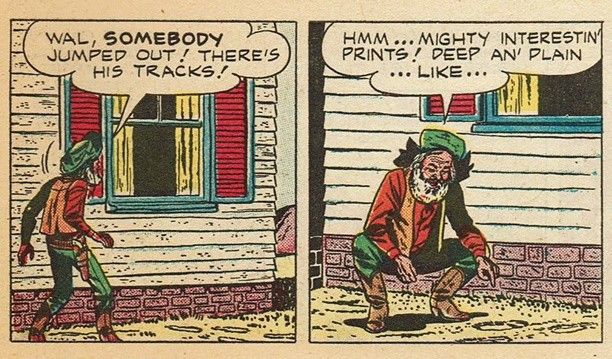Tracking Through Spaces
 Image by Юлия Антонова, CC-BY-SA 4.0, via Wikimedia Commons.
Image by Юлия Антонова, CC-BY-SA 4.0, via Wikimedia Commons.
Unlike skills, I have developed no comprehensive theory of the minigame.1 But thinking about them, this one example really took hold of me. It’s largely based on a throwaway idea by mindstorm Ty.
Imagining mostly characters exploring a large dangerous space like a depth crawl / flux space. There’s a stack of index cards. When you get an encounter sign, one of the players picks up an index card. Each card has three specific “signs” of something (hoof prints, blood stains, feathers). The player chooses one and describes what they find and how or whatever. The GM take the sign and links it to the encounter (found feathers? Harpy encounter next.) […] Might work better as some kind of Witcher-esque mechanic for monster hunting. You need to find x amount of the right “signs,” which means exploring for encounters.
There was a little more development, and I decided to take the idea and run with it.
Structure
I think this works best as a dense jewelbox design, with lots of opportunity to return, to look for specific things, and to find new connections. We also want to leave some room to “learn” the dungeon, despite its randomness.
So we’ll say that there are six kinds of encounter, and each encounter has three omens. However, in order to build ambiguity and enable some tension in other parts of the procedure, each omen could be one of two encounters. This leaves us with nine omens total. (All this math can be done with any even number of encounters. The number of omens will always be the number of encounters.)
We can change the “rarity” of a monster by tweaking the frequency of omens. As the number of omens will always be a multiple of three, we can split them evenly into common/uncommon/rare groups, and make our omen deck out of 3x/2x/1x of each, respectively.
Like every encounter table, it should have a dragon (scary, demanding tribute, or maybe just hungry), a wizard (like a dragon but probably won’t eat you), a recurring character, location-specific encounters, and generic encounters. Every encounter should check some box of the encounter checklist or have impact. As these encounters and omens actually form the bulk of play in this dungeon, they also need to enable faction play, expand world-building, integrate into a wider campaign, support some kind of ecology, and provide non-combat experiences (NPC interaction, traps, skill challenges, secrets). This is a lot to demand from only six encounters! So some of it will be sacrificed.
We’ll also need a table of locations for the omens and encounters to be found in, and a table of “twists” for those locations to keep them from feeling same-y. Similar to a micro-dungeon or more classical depth-crawl.
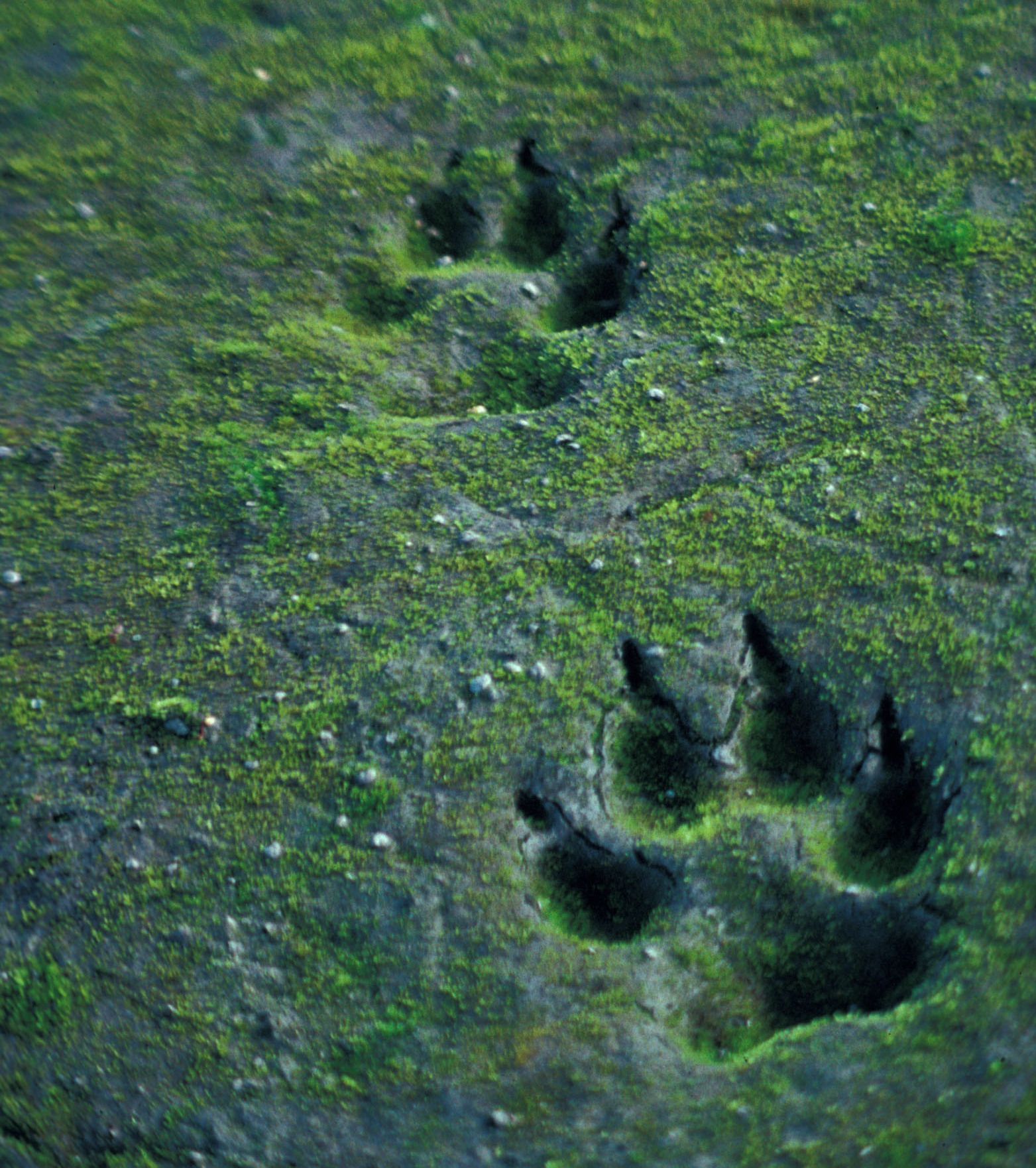 Image from U.S. Fish & Wildlife Service.
Image from U.S. Fish & Wildlife Service.
Procedure
- Roll an area and a twist (dX + followed omens).
- Check for encounters based on the players’ followed omens (see below). If multiple encounters are possible, they are both there. Discard all omens that are “used” by these encounters.
- Describe the area, the twist, and the encounters, as usual.
- When players want to move on, reveal the top three omens. Players choose one to follow (kept face-up in front of them), and discard the rest.
- Repeat. When the omen deck is empty, reshuffle the discard.
Checking for Encounters
Check the encounter table to see if the players have all three types of omen for any encounters. This is the roughest and most time-consuming part of the process, and needs work. If the dungeon is known to the players, the cards could be marked with the encounters they contribute to, like playing card suits and numbers, but this does remove ambiguity. If not, a JavaScript widget or other automation might be the best way to go.
Backtracking
Players may decide to avoid an area. Discard an omen to move back to the previous area.
Fleeing
If players are moving at speed (i.e. fleeing from combat), the GM secretly draws the top omen of the deck, and uses that in determining encounters and counting number of “followed” omens.
 Image by Tudor Washington Collins, CC-BY, via Wikimedia Commons.
Image by Tudor Washington Collins, CC-BY, via Wikimedia Commons.
Example: The Catacombs
Written, roughly, with ItO in mind. Inspirations include:
- A recent new candidate for sainthood, keeping the topic at the top of my mind.
- Beneath the Canals, a catacomb-delving RPG project with many authors.
- The Paris catacombs, where clandestine parties are still held.
- Necropolis, an essay that’s burrowed into the back of my head constantly.
If you’re playing in the playtest game, you may prefer to stop reading here.
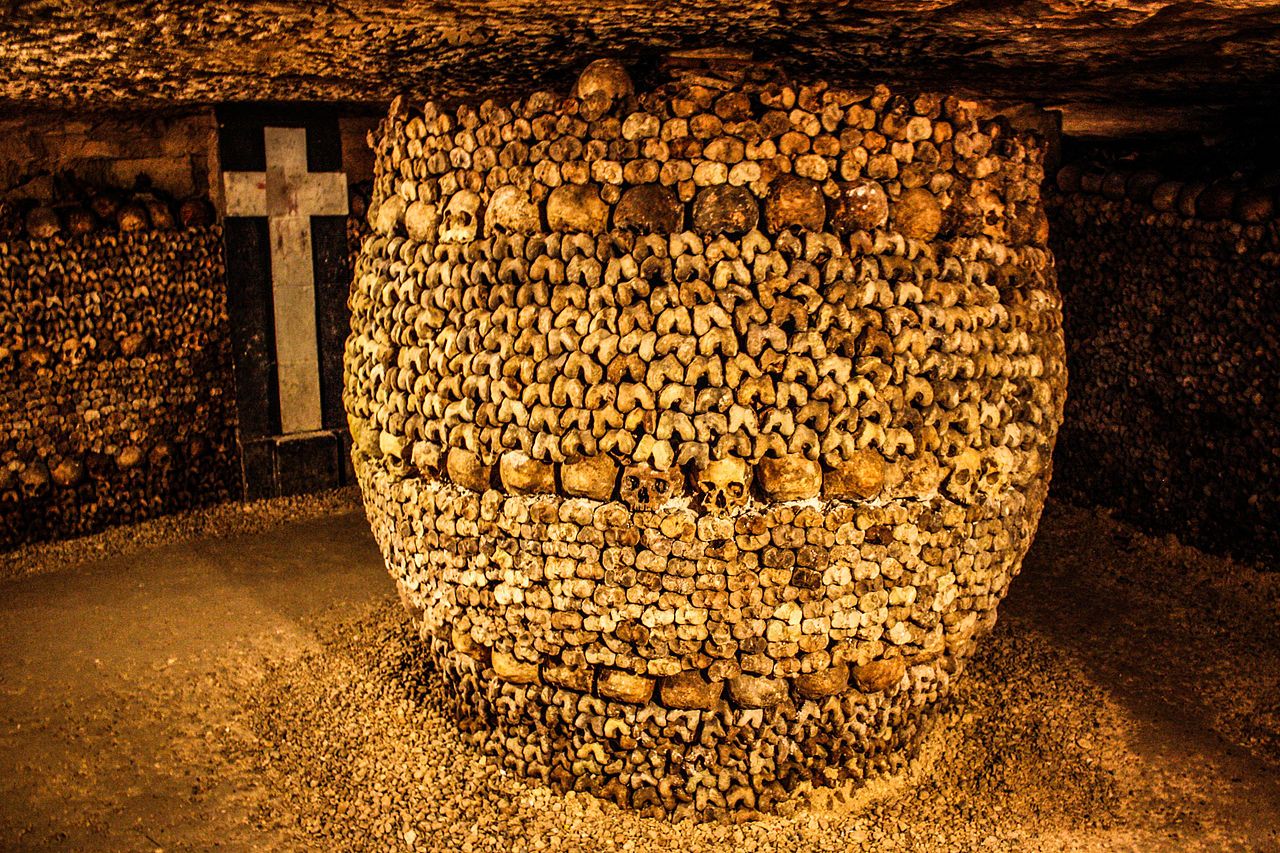 Image by Shadowgate, CC-BY 2.0, via Wikimedia Commons.
Image by Shadowgate, CC-BY 2.0, via Wikimedia Commons.
Omens
| Encounter | Marks | Whispers | Rattling | Incense | Ozone | Tomb | Floors | Pilgrim | Darkness |
|---|---|---|---|---|---|---|---|---|---|
| Pilgrims | X | X | X | ||||||
| Skeletons | X | X | X | ||||||
| Huecuva | X | X | X | ||||||
| Bonewax | X | X | X | ||||||
| Vampire | X | X | X | ||||||
| Criminal | X | X | X |
Marks (Common). Sacred fishes, monograms, simple arrows, obscure hobo marks, fresh obscenities. Written in chalk, scratched into soft stones, crafted from distinctively arranged bones.
Whispers (Common). A quiet sibilant sound. The echo of a suppressed noise.
Rattling (Common). A sharp clatter, as dice from a Yahtzee cup, or a shelf falling over, or indeed, bones.
Incense (Uncommon). A smell both comforting and exotic. Warming spices, pine, a touch of citronella.
Ozone (Uncommon). An acrid lightning odor. Bleach and grinding stones.
Open Tomb (Uncommon). A coffin-lid askew, a flagstone lifted, a sepulchre empty. Where should be death, there is nothing.
Clean Floors (Rare). Clear of rubble, debris, bones, dust. It even shines in the torchlight.
Dead Pilgrim (Rare). A new arrival to the neighborhood. Cause of death variable, but clearly recent.
Deep Darkness (Rare). Not your typical shadow, but a living, primal darkness. As silence is to sound. As a hand grasping air is to touch.
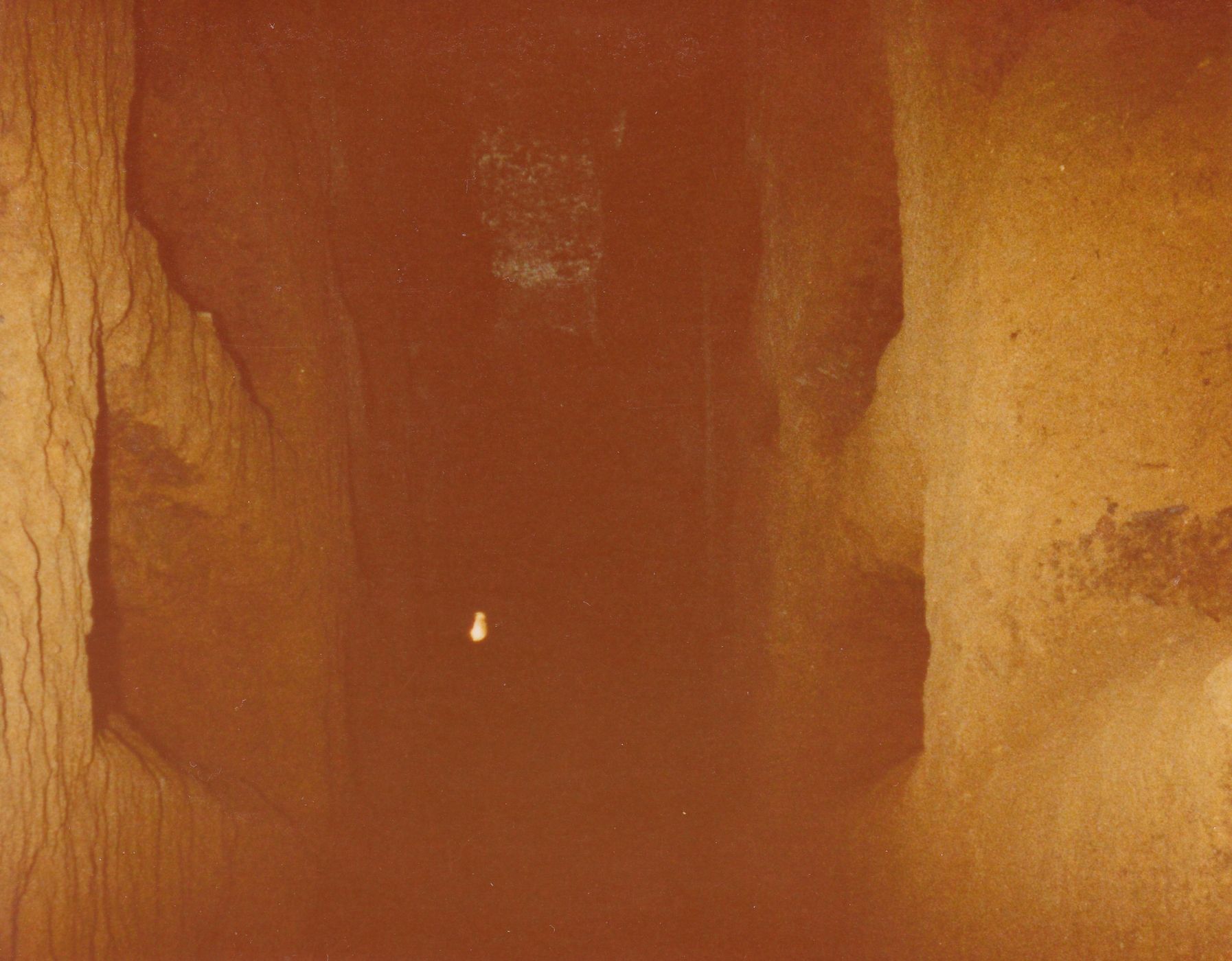 Image by CapCase, CC-BY 2.0, via Wikimedia Commons.
Image by CapCase, CC-BY 2.0, via Wikimedia Commons.
Encounters
Statted using danger and armor.
Pilgrims (d4a0)
- A band of 2d4 pilgrims seek the tomb of an ancestor or saint, marking their way.
- They know the top card of the omen deck, and can trade it with the players. They can also trade supplies.
- Omens: Marks, Whispers, Incense
Mien
- Completely lost
- Not lost
- “Not lost”
- Entrepreneurial
- Holier-than-thou (lit.)
- Overtaken by the sublimity of death; in shock
Treasure
- Consecrated chalk
- Brass thurible
- Ceramic grave foods
- Lead curse tablets
- Newspaper
- Rare drop
Skeletons (d4a1)
- When the skies open in the world above, and the storms rage, it’s said that the thunder is loud enough to wake the catacombs, 1d2 skeletons at a time.
- a3 against piercing weapons.
- Omens: Rattling, Ozone, Open Tomb
Mien
- Failing to eat ceramic grave foods
- Dancing (skeletons love to dance)
- Mimicking an Ooze (counts as an omen)
- Mimicking a Vampire (counts as an omen)
- Mimicking a Criminal (counts as an omen)
- Looking for other undead
Treasure
- Ceramic grave foods
- Brass mace of office
- Miniaturized capacitor bank
- Scrimshaw femur
- Living bones (inexplicable, but good for transplants)
- Rare drop
Huecuva (d4a2)
- As clerics shepherd followers in life, these anti-saints lead the dead astray.
- Attack clerics, pilgrims, and the openly faithful first.
- Omens: Marks, Rattling, Dead Pilgrim
Mien
- Proselytizing 1d4 lay skeletons
- Desecrating an altar
- Patrolling the perimeter of its territory
- Silently lecturing a captured pilgrim
- Mocking the inanimate dead
- Building its own reliquary
Treasure
- Heretical texts
- An unrelic—a cursed bone
- A defaced mitre, still bejeweled
- A ring on every finger
- Indulgences
- Rare drop
Bonewax Ooze (d6a3)
- A hot pale blob of plastic bones and molten wax, sloshing gently. Where bits of digested bone protrude from the pooling wax they spontaneously ignite, a flickering mass of accidental candles.
- a0 against brass weapons. Floats in water, but isn’t harmed by it.
- On critical damage, it eats a bone from the victim.
- Omens: Whispers, Ozone, Clean Floors
Mien
- Hungry for bones
- Hungry for wax
- Stuffed, obstructive
- Pooling
- Basking
- Digesting a loose skeleton
Treasure
- Block of pure wax [Bulky]
- Waxy bone-torches (1d6)
- A stilled ooze-heart
- A stilled ooze-heart
- Rare drop
- Rare drop
Royal Vampire (d12a1)
- The old royal family suffered from a congenital post-mortem curse. Now they occupy the deepest parts of the catacombs, keeping it as stately as a tunnel full of corpses can be.
- On critical damage, heal to full. Not affected by holy symbols, but other vampiric properties still apply.
- Omens: Incense, Clean Floors, Darkness
Mien
- Demanding tribute (wealth)
- Demanding tribute (news)
- Demanding tribute (blood)
- Starving (for blood)
- Keeping house
- Reading
Treasure
- Vampires always have a rare drop. Additionally, they can barter for any desired omen.
Criminal (d6a0)
- “Catacombs attract criminals. It’s just a fact!”
- If the party pursued someone specific into the catacombs, that person takes this slot. Otherwise, criminals can barter as pilgrims.
- Omens: Open Tomb, Dead Pilgrim, Darkness
Mien
- Struggling with a heavy tomb
- Talking to the rats
- On the lamb; in hiding; entering their “unsolved” era
- Praying for mercy
- Asleep, peaceful
- Already fleeing
Treasure
- Newspaper
- Giant gemstone
- Hand of Glory (1d4 fingers remain)
- Heretical texts
- Love letters
- Rare drop
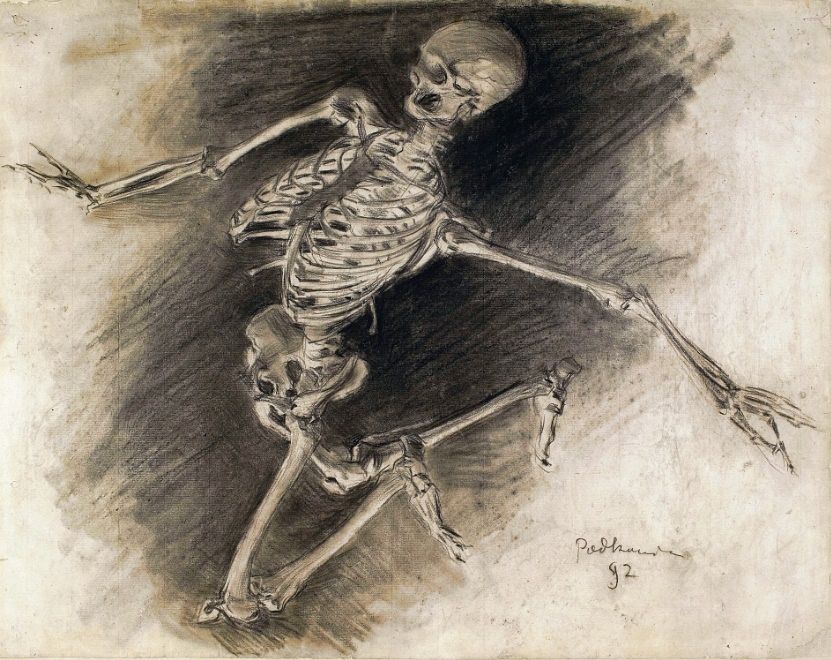 Image by Władysław Podkowiński, via Wikimedia Commons.
Image by Władysław Podkowiński, via Wikimedia Commons.
Other Tables
Areas (d12 + omens followed)
- Sewer (exit)
- Cellar (exit)
- Shrine
- Mithraeum
- Cathedral
- Crypt (stone sarcophagi)
- Ossuary (just bones)
- Sepulchre (carved niches)
- Reliquary (gilt sarcophagus)
- Columbarium (cremains)
- Hideout
- Sacred spring
- Mineshaft
- Archaeological dig
- Laboratory
- Throne room
- Living room
Twists (d12 + omens followed)
- Fresh flowers
- Graffiti
- Candles everywhere
- Musical
- Imposing
- Haunted
- Trail ends here (discard an omen)
- Cache of supplies
- Random encounter (roll for it, don’t consume omens)
- Frequented path (keep two omens)
- Loops back on itself (players may take the top discarded omen instead of a revealed one)
- Overlooks the next area (roll now)
- Absolutely smashed up, debris everywhere (attacks impaired)
- Peaceful (defer checking for encounters to next area)
- Flooded (lose any Ozone or Incense trails)
- Big pit
- Claustrophobic
Rare Drops (d6)
- Sacred sword. Standard +1 sword. Reaction rolls are lowest 2 of 3d6 for Pilgrims, highest for Huecuva.
- Heretic shield. Armor +1. Reaction rolls at highest 2 of 3d6 for Pilgrims, lowest for Huecuva.
- Loose relic. Of course it would be frowned upon to steal from a reliquary, but this one was missed. Uncatalogued, but verifiably miraculous.
- Spellbook. Learn yourself a bit of magic.
- Gold thurible. While lit, remove any one type of omen from the omen deck.
- Scrying crystal. Consume to count as one omen toward any encounter the players seek. Kept on exiting the catacombs.
Names
If names are needed, use Roman Names.
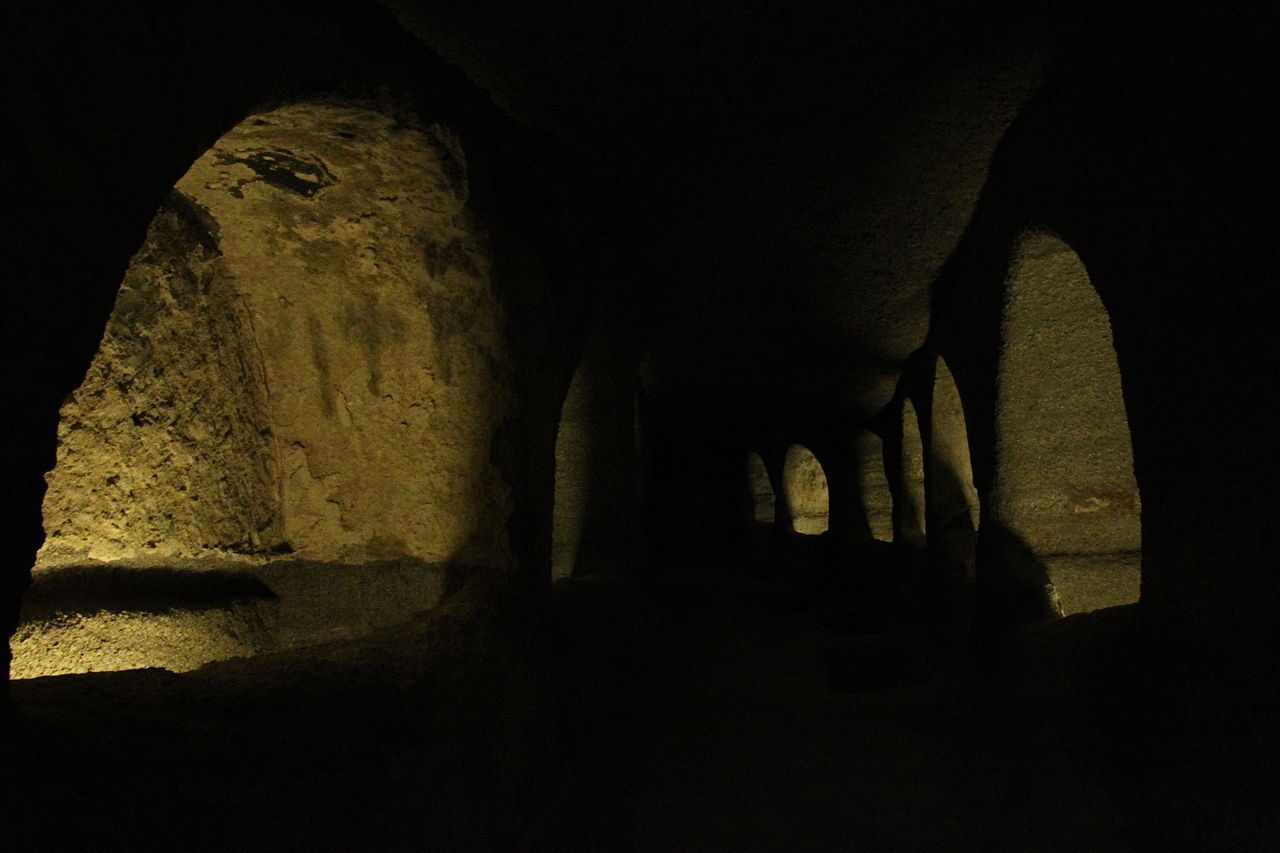 Image by Klearchos Kapoutsis, CC-BY 2.0, via Wikimedia Commons.
Image by Klearchos Kapoutsis, CC-BY 2.0, via Wikimedia Commons.
Notes
- This system could be re-skinned relatively simply. The intention behind the scrying crystal and the gold thurible is that they could be re-used in other dungeons. Other “hunting dungeons” might include a standard dungeon, a weird jungle, or an astral labyrinth.
- This isn’t quite a depth crawl or flux space: the abstraction here is purely the tracking of an encounter. Consequently, the “map” is not fixed. If you discard all your omens you can leave the dungeon, but you don’t necessarily go out the way you came in.
- It’s not necessary, but I thought it might be fun if the ooze-heart and the capacitor array combine to make a bone magnet. I tried to work on other connections between all the encounters.
- The encounters are different from a usual random encounter, in that, ideally, any of them could be actively sought out for some reason. Skeletons and pilgrims may become nuisances by consuming omens that could otherwise go toward the hunted encounter, but the dungeon can’t support too many of these.
- If you’re making your own re-skin, it isn’t a necessary conclusion that the matrix of omens and encounter will work out so perfectly. This is actually an instance of the bipartite realization problem, and there are many false starts.
- I believe that the most omens that can be followed at once in this scheme is five (six omens will necessarily trigger an encounter). I have not proven this.
- Why are my huecuva like this? There’s not much in the Fiend Folio, in modern D&D interpretations, or in the historical roots to support it. I don’t know.
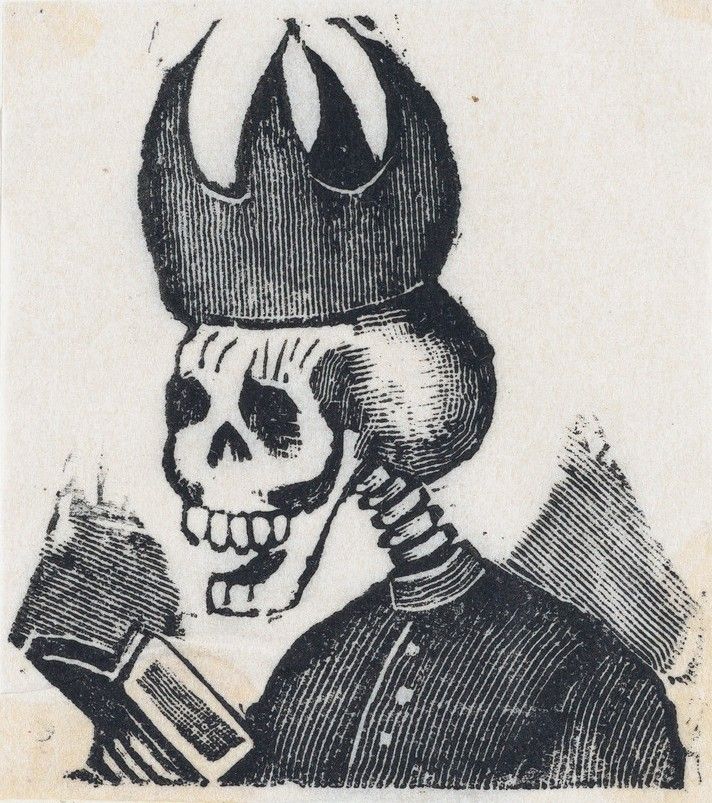 Image by José Guadalupe Posada, via Wikimedia Commons.
Image by José Guadalupe Posada, via Wikimedia Commons.
Playtesting
I’ve started playtesting the system already, although I haven’t yet got far enough to ask for player feedback. Putting the system into practice has highlighted some weak points, and I’ll be revising it in the future.
- I’ve found it useful to look at the omens before describing the area, so they can be worked into the description when relevant (for example, the dead pilgrim). This shifts the “navigational” decisions from in-between areas to within the areas themselves.
- Accounting for duplicates, the maximum “depth” is probably closer to 12 or 13 omens. This suggests we can roll a smaller die for area and twist, and refine those more narrowly. I want to keep the “random” encounter near the middle of it, so that it’s a possibility at any depth.
- With duplicates, some rooms may offer only duplicate omens, and duplicate omens can’t lead to an encounter.
- “Lose an omen” is an un-fun feeling twist. I may move it to the highest-numbered position on the table as a type of fallback.
- I mocked up the cards physically, which is very satisfying. As the playtest is online, I regret that this aspect is difficult to communicate.
- I wonder how a version of the system completely devoid of any crawling might feel, i.e. with only omens and encounters.
- Checking for encounters is not so onerous a task as it seems at first. Since players can only follow one new omen at a time and there are only two possible encounters for each omen, only four other omens need to be checked (usually). This could still get out of hand in a more complicated arrangement.
The system used has been Into the Odd with 2d6 reaction rolls from The Black Hack and each character starting with a torch. Exploring an area and navigating to the next consumes ⅙ of a torch, and when there are no torches, players are forced to leave the catacombs and “end the run.”
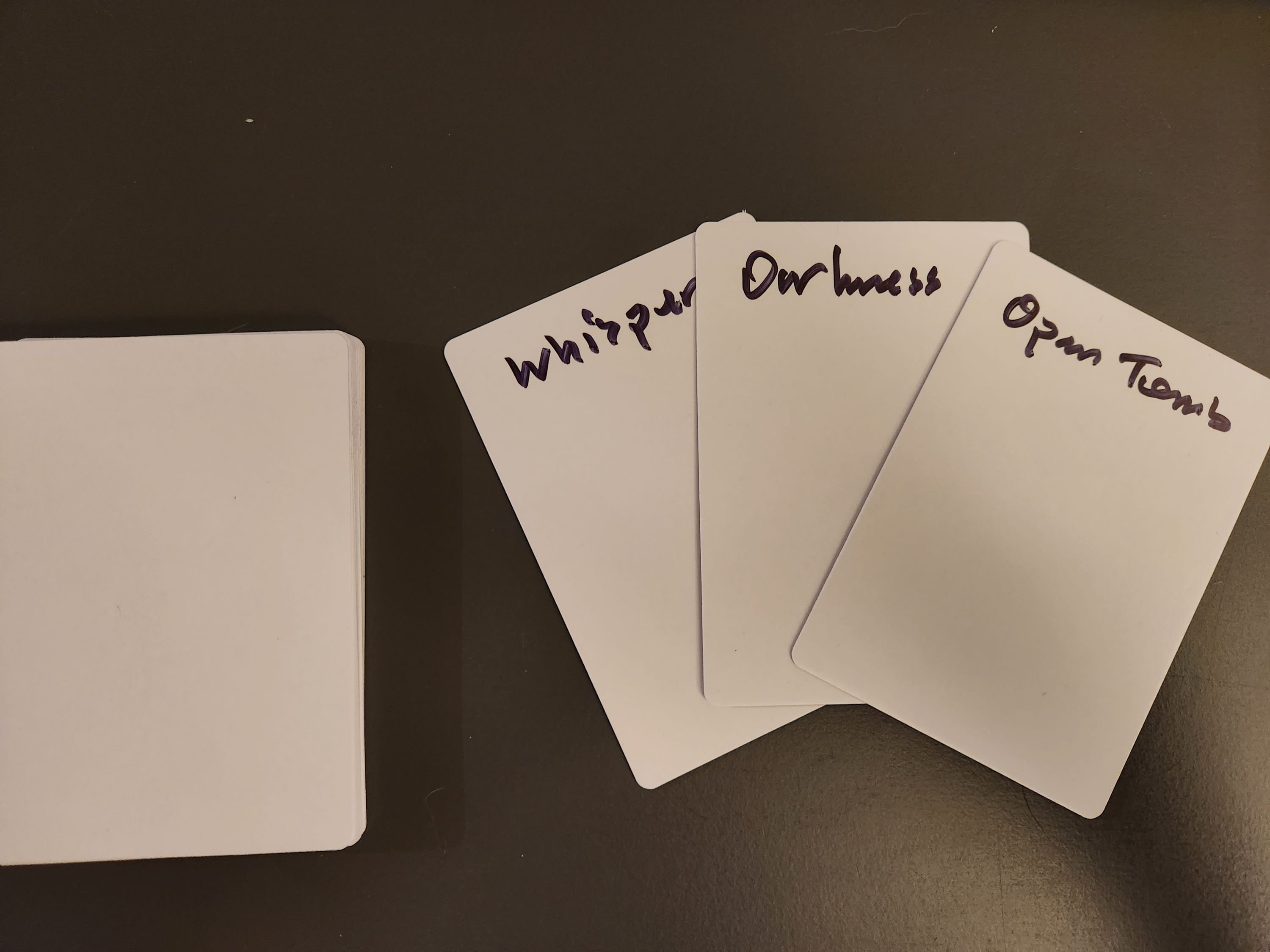 Playtesting
Playtesting
For tracking purposes, I’m considering this part of the RuneScape series, but I won’t really be bringing it up again here, as I think the system is more easily broken out and repurposed than the others in that vein.↩︎
